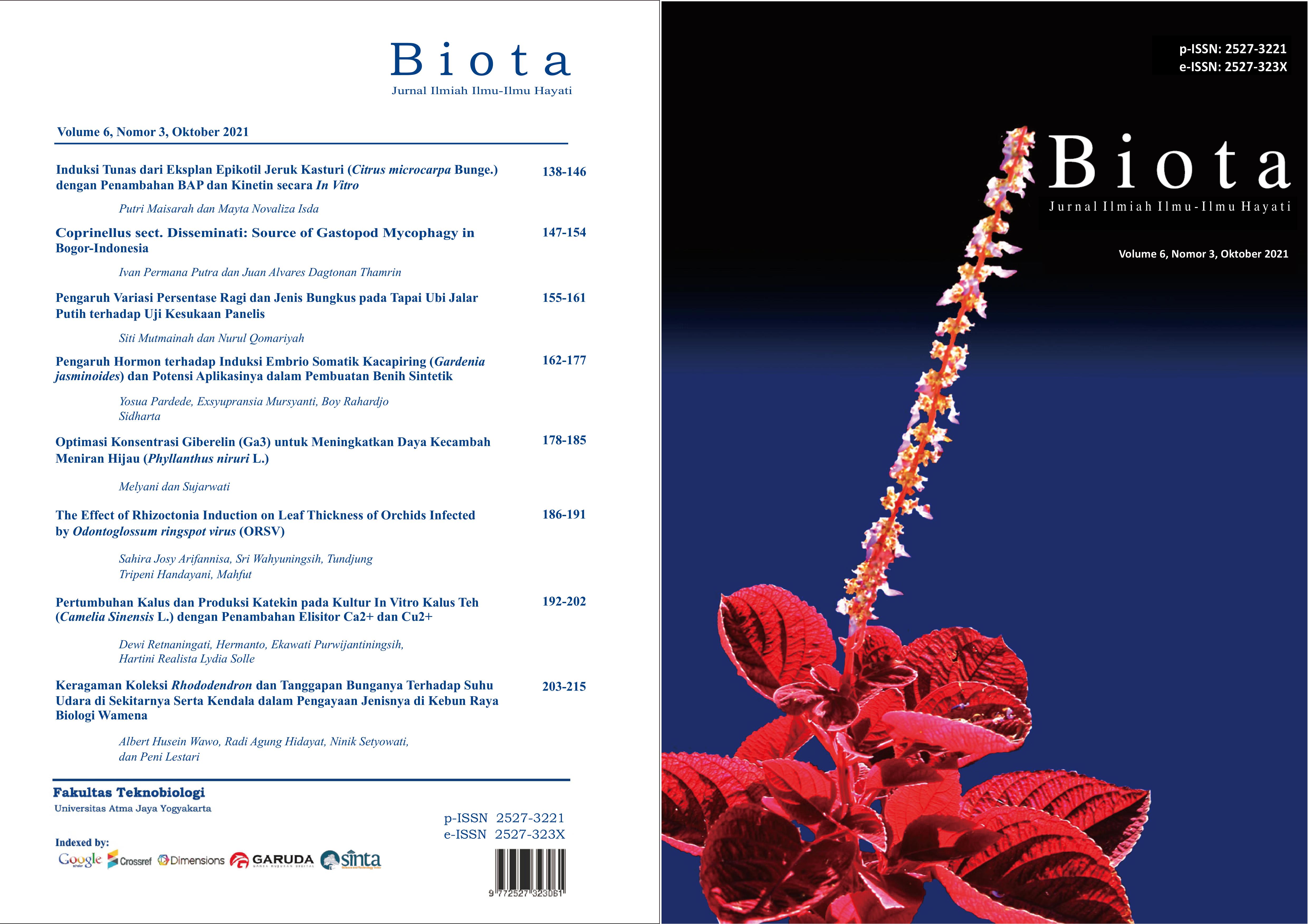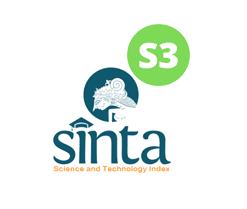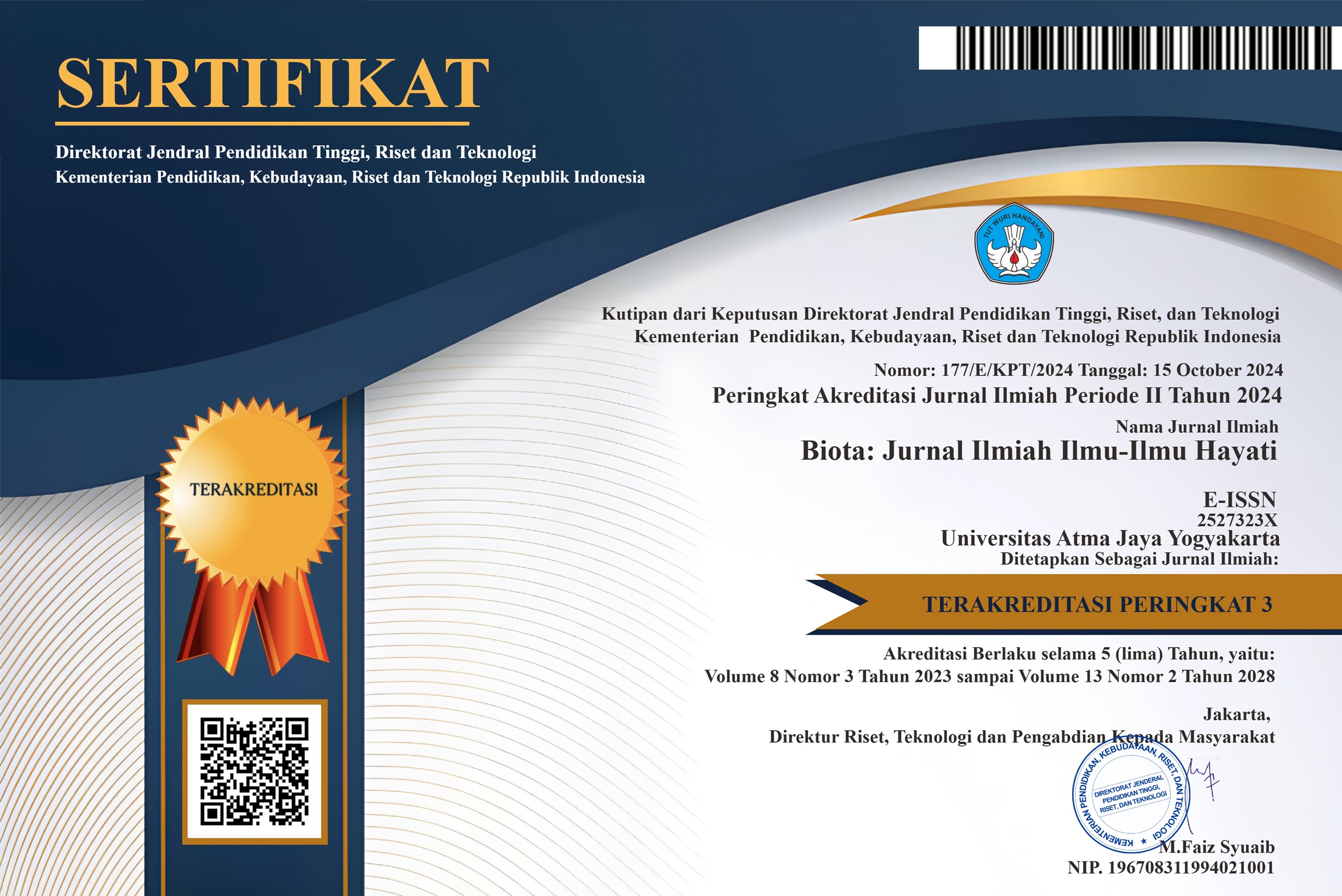Coprinellus sect. Disseminati: Source of Gastropod Mycophagy in Bogor-Indonesia
DOI:
https://doi.org/10.24002/biota.v6i3.3316Keywords:
Coprinellus sect. Disseminati, Macrofungi, Mycophagy, Gastropod, IPB UniversityAbstract
Mycophagy is the process of the organism consuming fungi. Fungal tissue considered as valuable resource with high nutritional content for organisms which have the metabolic abilities to digest it. To date, there is no previously published record of animal mycophagy in Indonesia. Field observations in IPB University Campus Forest has been done to monitor mycophagy activity by any animals in sampling site. Only 1 of the 4 observasion period showed the evidence of animal mycophagy in sampling site. Mycophagous gastropod found to consume Coprinellus disseminatus fruit body as diet source. Macrofungi fruit body was eaten within two to three minutes. The snail only consume the pileus part of fruit body of Coprinellus disseminatus. It showed to use it’s anterior tentacles to pick the stages of fruit body. The gastropod tend to prefer mature fruitbody, yet the the reasons are still not clear. This is the first report of animal mycophagy evidence in Indonesia.
References
Ademolu, K. O., Fakeye, O. D., Dedeke, G. A., Ajayi, O. A., & Idowu, A. B. (2013). Digestive enzymes in African Giant land snail (Archachatina marginata) during aestivation. Archivos de Zootecnia, 62(237): 73–77.
Arora, D. (1986). Mushrooms Demystified. Ten Speed Press. California.
Boddy, L., & Jones, T. H. (2008). Chapter 9: Interactions Between Basidiomycota and Invertebrates. British Mycological Society Symposia Series 28 (pp.155–179). Academic Press. London.
Chang, S.T., & Miles, P. (2004). Mushrooms : cultivation, nutritional value, medicinal effect, and enviromental impact 2nd edition. CRS Press. NewYork.
Claridge, A. W. (2002). Ecological role of hypogeous ectomycorrhizal fungi in Australian forests and woodlands. Diversity and Integration in Mycorrhizas (pp.291–305).
Desjardin, D. E., Wood, M., & Stevens, F.A. (2014). California mushrooms: The comprehensive identification guide. Timber Press. Oregon.
Elliott, T. (2019). Reptilian mycophagy: a global review of mutually beneficial associations between reptiles and macrofungi. Mycosphere 10(1): 776-797.
Fogel, R., & Trappe, J.M. (1978). Fungus consumption (mycophagy) by small mammals. Northwest Science 52(1): 1-31.
Gu, Y.H., & Leonard, J. (2006). In vitro effects on proliferation, apoptosis and colony inhibition in ER-dependent and ER-independent human breast cancer cells by selected mushroom species. Oncology Reports 15 (2): 417-423.
Han, B., Toyomastu, T., & Shinozawa, T. (1999). Induction of Apoptosis by Coprinus disseminatus Mycelial Culture Broth Extract in Human Cervical Carcinoma Cells. Cell Structure and Function 24(4): 209–215.
Hoffman, G. D., & Rao, S. (2013). Association of slugs with the fungal pathogen Epichloë typhina (Ascomycotina: Clavicipitaceae): potential role in stroma fertilisation and disease spread. Annals of Applied Biology 162(3): 324–334.
Keller, H. W., & Snell, K. L. (2002). Feeding activities of slugs on Myxomycetes and macrofungi. Mycologia, 94(5): 757–760.
Læssøe, T., Pedersen, O.,& Sysouphanthong, P. (2019). Introduction to the Edible, Poisonous and Medicinal Fungi of Northern Laos. Agro-Biodiversity Project. Laos.
Lestari, A. S., Zulfiana, D., Ismayati, M., Zulfitri, A., Krishanti, N. P. R. A., Kartika, T., & Yusuf, S. (2019). Morphological diversity of Agaricomycetes in Kuningan Botanical Garden, West Java, Indonesia. IOP Conference Series: Earth and Environmental Science 374: 1-5.
Lilleskov, E. A., & Bruns, T. D. (2005). Spore dispersal of a resupinate ectomycorrhizal fungus, Tomentella sublilacina, via soil food webs. Mycologia 97(4): 762–769.
Lundgren, J. G. (2009). Relationships of Natural Enemies and Non-Prey Foods. North Central Agricultural Research Laboratory. Brookings.
Maekawa, N., Shirouzu, T., Jaco, R.,Y.,P., Aguilar, B.,E.,C., & Nakagiri, A. (2013). Mushrooms of El Salvador. FMRC and CENTA. Tottori.
McKnight, K., & Vera, M. (1998). A Field Guide to Mushrooms: North America (Peterson Field Guides). Houghton Mifflin. Boston.
Merritt, J.F. (2010). The Biology Of Small Mammals. The Johns Hopkins University Press. Baltimore.
Moore, P. D. (1996). Invertebrates and mycophagy. Nature 381(6581): 372–373.
Novakovic, A., Karaman, M., Kaisarevic, S., Belovic, M., Radusin, T., Beribaka, M., & Ilic, N. (2016). Coprinellus disseminatus (Pers.) J.E. Lange 1938: In vitro antioxidant and antiproliferative effects. Food and Feed Research 43(2): 93–101.
Novaković, A., Karaman, M., Milovanović, I., Torbica, A., Tomić, J., Pejin, B., & Sakač, M. (2018). Nutritional and phenolic profile of small edible fungal species Coprinellus disseminatus (pers.) J.E. Lange 1938. Food and Feed Research 45(7): 119–128.
Putra, I.P., Mardiyah, E., Amalia N,S., & Mountara, A. (2017). Ragam jamur asal serasah dan tanah di Taman Nasional Ujung Kulon Indonesia. Jurnal Sumberdaya HAYATI 3(1): 1-7.
Putra, I. P., Sitompul, R., & Chalisya, N. (2018). Ragam Dan Potensi Jamur Makro Asal Taman Wisata Mekarsari Jawa Barat. Al-Kauniyah: Jurnal Biologi 11(2): 133–150.
Putra, I. P., Nasrullah, M. A., & Dinindaputri, T. A. (2019). Study on Diversity and Potency of Some Macro Mushroom at Gunung Gede Pangrango National Park. Buletin Plasma Nutfah 25(2): 1-14.
Putra, I.P., Amelya, M.P., Nugraha, N.H., & Zamia, H.Z. (2019) .Notes of Some Macroscopic Fungi at IPB University Campus Forest: Diversity and Potency. Biota 12(2): 57-71.
Putra, I.P. (2020). Record On Macroscopic Fungi At IPB University Campus Forest : Description And Potential Utilization. IJOSE 4(1): 1-11.
Ribeiro, B., Guedes de Pinho, P., Andrade, P. B., Baptista, P., & Valentão, P. (2009). Fatty acid composition of wild edible mushrooms species: A comparative study. Microchemical Journal 93(1): 29–35.
Simpson, J.A. (2000). More on mycophagous birds. Australian Mycologis,19(2): 49-51.
Solle, H.R.L, Kalu, F., & Nuhamara, S.T. (2018). Keanekaragaman Jamur di Cagar Alam Gunung Mutis Kabupaten Timor Tengah Utara, Nusa Tenggara Timur. Journal of Biota 2(3): 105-110.
Tampubolon, S.D.B., Utomo, M., & Yunasfi, B. (2013). The diversity of macroscopic fungi in the education forest of University of Sumatera Utara, Tongkoh Village, Karo District, North Sumatra Province. Peronema For. Sci. J , 2: 176-182.
Tanney, J. B., & Hutchison, L. J. (2011). A Brief Survey of Mycophagy in Ruffed Grouse, Bonasa umbellus, from Northwestern Ontario. The Canadian Field-Naturalist, 125(1): 72-73.
Trappe, J. M., Molina, R., Luoma, D. L., Cázares, E., Pilz, D., Smith, J. E., & Trappe, M. J. (2009). Diversity, Ecology, And Conservation of Truffle Fungi In Forests of The Pacific Northwest. U. S. Departement of Agrivulture. Portland.
Trierveiler-Pereira, L., Silva, H.C.L., Funez, L.A., & Baltazar, J.M. (2016). Mycophagy by small mammals: new and interesting observations from Brazil. Mycosphere 7(3): 297-304.
Vasco-Palacios, A. M., Suaza, S. C., Castanõ-Betancur, M., & Franco-Molano, A. E. (2008). Conocimiento etnoecólogico de los hongos entre los indígenas Uitoto, Muinane y Andoke de la Amazonía Colombiana. Acta Amazonica 38(1): 17–30.
Wächter, D. & Melzer, A. (2020). Proposal for a subdivision of the family Psathyrellaceae based on a taxon-rich phylogenetic analysis with iterative multigene guide tree. Mycological Progress 19(11): 1151–1265.
Downloads
Published
How to Cite
Issue
Section
License
Copyright (c) 2021 Ivan Permana Putra, Juan Alvares Dagtonan Thamrin

This work is licensed under a Creative Commons Attribution-NonCommercial 4.0 International License.
Authors who publish with Biota : Jurnal Ilmiah Ilmu-Ilmu Hayati agree to the following terms:
- Authors retain copyright and grant the Biota : Jurnal Ilmiah Ilmu-Ilmu Hayati right of first publication. Licensed under a Creative Commons Attribution-NonCommercial 4.0 International License that allows others to share the work with an acknowledgment of the work's authorship and initial publication in this journal.
- Authors are able to enter into separate, additional contractual arrangements for the non-exclusive distribution of the journal's published version of the work (e.g., post it to an institutional repository or publish it in a book), with an acknowledgment of its initial publication in Biota : Jurnal Ilmiah Ilmu-Ilmu Hayati, and as long as Author is not used for commercial purposes.













